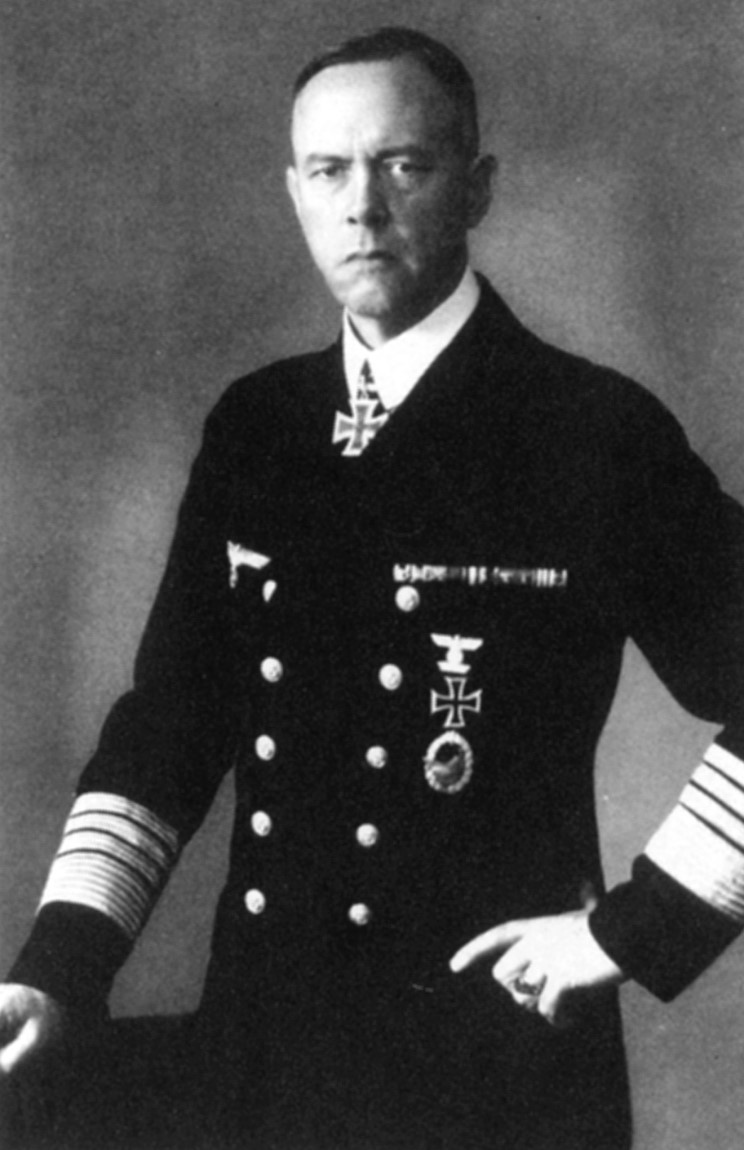Admiral Günther Lütjens |
|
(1889-1941) |
 |
| Admiral Günther Lütjens. |
 |
May 5, 1941: Admiral Günther Lütjens (seen to the right of Adolf Hitler) escorts der Führer on his inspection of the Bismarck. To Hitler's left is Field Marshall Wilhelm Keitel (just over Hitler's right shoulder) and Kapitän zur See Ernst Lindemann, Bismarck's commanding officer (second from left). |
Günther Lütjens was born in Wiesbaden, Germany, and entered the Imperial German Navy (Kaiserliche Marine) school in 1907. He spent his initial years on the light cruiser SMS Freya. After receiving his commission he served on board the battleship SMS Elsass until 1910, from 1910 to 1913 aboard the armed cruiser SMS König Wilhelm, and from 1913 until the end of World War I as commander of torpedo boats along the Flemish coast, leading raids against Dunkerque. After the war, he worked as an officer at the Warnemünde Ship Transportation Agency from 1918 until 1921, when he returned to the newly reorganized German Navy again as a Commander. Lütjens served until 1925 in the 3rd Torpedo Boat Flotilla. He was later promoted to commander of the flotilla. In 1933 he received command of the Light Cruiser Karlsruhe. In 1936 Lütjens was appointed Chief of Personnel of the Kriegsmarine. 1937 he became Führer der Torpedoboote (Leader of the Torpedo Boats) and was promoted to Rear Admiral. In November 1938 Lütjens was one of only three flag officers who protested in writing against the atrocities committed by Nazi thugs during the pogroms against Jewish citizens, synagogues and property during the so-called "Kristallnacht". At the outbreak of World War II Lütjens was Commander of Scouting Forces. In April 1940, during the invasion of Denmark and Norway (Operation Weserübung, he served as Vice Admiral, commanding the distant cover forces in the North Sea that consisted of the battlecruisers Scharnhorst and Gneisenau and fighting an inconclusive battle with HMS Renown. In June 1940 he became Commander of Battleships and the third Flottenchef (Fleet Commander) of the Kriegsmarine in World War II, a position comparable to the British Commander-in-Chief of the Home Fleet. His predecessor, Vice Admiral Wilhelm Marschall, had repeated differences with the German High Command over the extent the Flottenchef should be bound to orders while operating at sea. Operating from the Scharnhorst and the Gneisenau, Marschall had realized the Allies were retreating from Norway and ignored his original orders by attacking the retreating British forces, sinking the carrier HMS Glorious and its escorting destroyers HMS Acasta and HMS Ardent, but also receiving a torpedo hit on the Scharnhorst. This failure to follow orders resulted in Marschall being replaced by Lütjens. Since the first Flottenchef had been removed for similar reasons, Lütjens was determined to follow his orders to the letter to avoid suffering the same fate. In early 1941 he commanded the Scharnhorst and the Gneisenau in an Atlantic raid, during which he destroyed over 115,000 tons of Allied merchant shipping before returning to Brest, France. Plans were then made for Lütjens to command Operation Rheinübung, taking all four German battleships and battlecruisers -- Bismarck, Tirpitz, Scharnhorst and Gneisenau -- on a raid into the Atlantic . For various reasons, the Tirpitz and the two battlecruisers could not be made ready for the operation, so it proceeded with only the Bismarck and the heavy cruiser Prinz Eugen. After rounding Iceland, Lütjens encountered a British squadron in the Denmark Strait comprising the battleships HMS Hood and HMS Prince of Wales in the early hours of 24 May 1941. During the brief battle that followed, HMS Hood was sunk with nearly all hands lost, and HMS Prince of Wales was heavily damaged. Lütjens decided to let her escape, following his orders to avoid engagements with equal or superior forces unless forced to by the enemy. The Prinz Eugen was subsequently ordered to initiate commerce raiding on her own. In subsequent maneuvering, the Bismarck was able to elude the British, although her crew was unaware of this, since they could detect British radar but did not know that the return signals were too weak to be monitored. Unaware that the British had "lost" him, and in spite of the Bismarck's Captain Lindemann's objections, Lütjens transmitted a half-hour radio message which was intercepted by the British and used to locate the ship. The Bismarck was subsequently spotted by a reconnaissance aircraft flying from Northern Ireland. On 26 May, at dusk, she was attacked by British Swordfish torpedo planes from the aircraft carrier HMS Ark Royal. One torpedo jammed her rudder and steering gear, rendering her largely unmaneuverable. The crew were still able to steer the Bismarck somewhat by adjusting the revolution speed of her propellers, but it greatly reduced her speed. Throughout the following night she was the target of incessant torpedo attacks by the destroyers HMS Cossack, HMS Sikh, HMS Maori and HMS Zulu, along with the Polish destroyer Piorun. The battleships HMS King George V and HMS Rodney, accompanied by several cruisers and destroyers, inflicted severe damage on the Bismarck. Although the Bismarck 's upper works were almost completely destroyed, her engines were still functioning and the hull appeared to be relatively sound; therefore, rather than risk her being captured, one of the remaining senior officers gave the order to scuttle and then abandon ship. Many of the crew went into the water, but a few sailors from the lower engine spaces also got out alive. 118 crew members were saved, while 2106 died. Lütjens was among those who lost their lives -- probably killed when a salvo fired by HMS King George V destroyed the bridge, together with the central artillery control tower, killing many senior officers. This was caused when a high-caliber shell plunged into the Bismarck 's bows, probably detonating an explosive, which would explain the subsequent destruction of much of the ship's forward works, including the two forward turrets (Anton and Bruno). |
(Text from Wikipedia) |
Admiral Günther Lütjens |
||
Page published Apr. 14, 2007 |